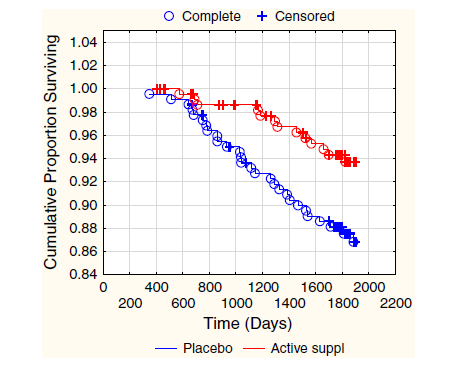
The researcher and cardiologist, Professor Urban Alehagen, asks the question: how much more clinical evidence of the beneficial heart-related health effects of a combo Coenzyme Q10/Selenium supplementation within an elderly Swedish population do we need? He points to the results looking at 18 publications from the set of data based on the randomized controlled trial, the KiSel-10 Study.
As a professor and cardiologist at Linköping University and the Linköping University Hospital in Sweden, I was one of the researchers in the multi-center Q-Symbio Study of the effect of Coenzyme Q10 adjuvant therapy on morbidity and mortality in chronic heart failure. In that randomized controlled trial, we gave 420 patients 3 x 100 mg of Coenzyme Q10 in divided doses taken with meals or matching placebos daily for two years.
The trial outcomes showed that the CoQ10 treatment added on to the patients’ conventional heart failure medication was associated with a significant reduction in the symptoms and a significant improvement in the survival of the heart failure patients [Mortensen 2014].
In many ways, the Q-Symbio Study was an affirmation of the earlier Italian multi-center study in which the researchers gave 641 heart failure patients two milligrams of Coenzyme Q10 per kilogram of body weight per day or placebos for a year.
That daily dose (approximately 200 mg per day for a man and 150 mg per day for a woman) of Coenzyme Q10 significantly reduced the patients’ rates of hospitalization, pulmonary edema (i.e. fluid collecting up into the lungs), and cardiac asthma (i.e. wheezing) [Morisco 1993].
Special Relationship Between Coenzyme Q10 and Selenium
At the same time that I was involved in the Q-Symbio Study, I was aware of the work of researchers at Karolinska Institutet in Stockholm. They were finding that the reduced form of Coenzyme Q10, called ubiquinol, is regenerated by three flavoenzymes lipoamide dehydrogenase, thioredoxin reductase and glutathione reductase [Nordman 2003; Xia 2003].
In particular, two things caught my attention:
- Selenium in the form of the selenoprotein thioredoxin reductase (TrxR1) is needed for the cells to reduce Coenzyme Q10 (ubiquinone) to its antioxidant form, which is called ubiquinol.
- The synthesis of the selenocysteine containing selenoproteins, including TrxR1, requires a functional mevalonate pathway in which Coenzyme Q10 (ubiquinone form), along with cholesterol and dolichol, is a product.
It seemed clear: There is a synergy between Coenzyme Q10 and selenium containing enzymes in the body. An adequate Coenzyme Q10 status is necessary for the optimal functioning of the selenoproteins. Likewise, a low selenium status could restrict the cells’ ability to obtain the optimal concentrations of Coenzyme Q10 [Alehagen 2015a].
Low Coenzyme Q10 and Low Selenium Status in the Elderly
I knew that, starting in our 20’s, our cells’ bio-synthesis of Coenzyme Q10 declines with increasing age, such that the heart muscle cells in an 80-year-old person may produce only half as much Coenzyme Q10 as a 20-year-old person’s heart muscle cells would.
I knew that dietary selenium intakes in Sweden are quite low. Estimates for adequate dietary selenium intakes range from 75 to 105 micrograms per day. In the elderly people in Kinda county/municipality, aged 70-88 years, we estimated that the dietary selenium intake was only on the order of 35 micrograms per day, based on the blood concentration of selenium in the population. We found that mean serum selenium concentration in a large sample of elderly Swedish citizens was 67.1 micrograms per liter, considerably below the physiological saturation level for several important selenoprotein enzymes [Alehagen 2016].
Rationale for a Combined Coenzyme Q10 + Selenium Trial
Not much research had been done on the potential cardiovascular benefits of combined Coenzyme Q10 and selenium supplementation. A few studies indicated that the combined supplementation with a mix of nutrients including selenium and Coenzyme Q10 might affect heart function positively [Leong 2010; Witte 2005]. Only one small study from the former East Germany indicated that the combination of selenium and Coenzyme Q10 might have positive effects on patients with a myocardial infarction [Kuklinski 1994].
Accordingly, we recruited 443 elderly people still living at home in the region to the south of Linköping to take part in a four-year randomized controlled trial of the effects of combined Coenzyme Q10 and selenium supplementation on cardiovascular mortality and heart function.
The study participants in the active treatment group received 1 x 100 mcg of selenium from a high-selenium yeast tablet twice a day and 1 x 100 mg capsule of Coenzyme Q10 twice a day. The study participants in the other half of the study received matching placebos [Alehagen 2013].
Given the biochemical interrelationship between Coenzyme Q10 and selenium, we wanted to see whether the combined supplementation with Coenzyme Q10 and selenium could improve the cardiovascular health of elderly people and influence perceived health-related quality-of-life [Alehagen 2013; Johansson 2015].
Initial Outcomes of the KiSel-10 Study
Our study took the name KiSel-10 (eponymous for selenium and Q10 study in Kinda county/municipality).
The results after an initial 5.2-year median follow-up period showed the following statistically significant results [Alehagen 2013]:
- A relative 53% reduction in the incidence of cardiovascular deaths, from 12.6% in the placebo group to 5.9% in the active treatment group
- A reduction in NT-proBNP proteins, a biomarker of tension within the heart muscle indicative of heart failure, in the active treatment group.
- Improved heart function in the active treatment group as measured with echocardiography

Cumulative proportion surviving over time with the combined selenium and Coenzyme Q10 supplementation. Censored participants were participants who were still alive at the end of the study period or who had died of reasons other than cardiovascular disease. Completed participants comprised those who had died due to cardiovascular disease.
12-Year Follow-Up Outcomes of the KiSel-10 Study
In 2018, we published the results of a 12-year follow-up of the survivors of the initial four-year intervention with the Coenzyme Q10 + selenium or matching placebos. We found that, even after 12 years, which included the eight-year period following the termination of the intervention, there was a continual and significant reduction in the risk of cardiovascular mortality in the active treatment group [Alehagen 2018a].
There was also significantly reduced risk of cardiovascular mortality in subgroups of patients with diabetes, hypertension, ischemic heart disease, or impaired functional capacity [Alehagen 2018a].
Mechanisms of Heart Function Protection by Coenzyme Q10 and Selenium
Of course, we asked ourselves: what biochemical mechanisms could explain these results? What was the Coenzyme Q10 and selenium combination doing in the cells to preserve and even improve the heart function of these elderly people?
From the KiSel-10 Study, we had something like 60,000 blood samples. In the intervening years, we had been doing analyses of the differences between the blood samples drawn from the people treated with Coenzyme Q10 and selenium and drawn from the people treated with placebos. We had found that the Coenzyme Q10 and selenium combination had given the following health benefits compared to placebo:
- Significantly reduced the presence of two bio-markers for oxidative stress. Oxidative stress is, simply put, an imbalance in the cells between harmful free radicals and protective antioxidants. Both Coenzyme Q10 and several selenoproteins are known to have antioxidative effects [Alehagen 2015b].
- Significantly reduced the presence of several bio-markers for inflammation. This was important both because inflammation and atherosclerosis are inter-related conditions and because elevated levels of inflammation are associated with the aging process itself [Alehagen 2015c, Alehagen 2019a].
- Significantly reduced the levels of several bio-markers of fibrogenic activity. As fibrosis is one of the main findings in the cardiovascular system of the ageing process, it seems that the supplementation of selenium and Coenzyme Q10 might influence this process in those with a deficiency of the two substances [Alehagen 2018b].
- Significantly increased the levels of insulin-like growth factor 1 (IGF-1) and insulin-like growth factor binding protein 1 in the people taking Coenzyme Q10 and selenium supplements. At the same time, people in the placebo group had reduced IGF-1 concentrations. IGF-1 levels are in decline as we are growing older, and many diseases also decreases the level of IGF-1. A lower level of IGF-1 is also associated with increased cardiovascular risk. IGF-1 does have many useful functions related to cell growth and metabolism as well as having antioxidative and anti-inflammatory effects [Alehagen 2017].
Metabolic Explanations for the Heart Health Benefits of Coenzyme Q10 and Selenium
We continued our investigations of differences in the blood of elderly people who had taken Coenzyme Q10 and selenium supplements daily for four years and in the blood of elderly people who had taken placebos.
At one point, we became interested in metabolomics, the study of the chemical processes involving metabolites. Metabolites are the molecular substrates, intermediates, and products of cell metabolism.
We wanted to see if there were differences in the metabolite profiles of people in the two groups.
Using blood samples from a smaller sub-set of men enrolled in the KiSel-10 Study, we made the following findings [Alehagen 2019b]:
- 19 out of 95 identified metabolites were significantly decreased following 18 months of intervention.
- There were significant changes in the pentose phosphate, the mevalonate, the beta-oxidation, and the xanthine oxidase pathways.
- There were also changes in the urea cycle and increases in the levels of the precursors to neurotransmitters of the brain.
Clearly, there were major differences in the metabolic profiles of the men in the active treatment group and men in the placebo group. These effects, together with signs of less oxidative stress, less inflammation, and less fibrosis, indicate that combined Coenzyme Q10 and selenium supplementation has a positive health effect compared with placebo.
MicroRNA Changes Associated with Coenzyme Q10 + Selenium
In a small sub-set of male participants in the KiSel-10 Study, we found that four years of treatment with Coenzyme Q10 and selenium was associated with significant differences in the expression of 70 different microRNAs; up to a four-fold difference in expression could be noted.
MicroRNAs are molecules that regulate gene expression and regulate the production of proteins, and one microRNA can regulate up to more than 1000 different proteins. Moreover, microRNAs are thought to be involved in the development of heart disease and diabetes.
Thus, the effect on microRNAs could well be one of the biochemical mechanisms by which Coenzyme Q10 and selenium supplementation reduces the level of inflammation and the risk of death from heart disease.
Additional Evidence for Beneficial Heart Health Effects of Coenzyme Q10 and Selenium Supplementation
So, now I am back to my original question: how much more clinical evidence for a beneficial effect of a specific combo of Coenzyme Q10 and selenium do we need?
One study: KiSel-10 initial results
The initial study outcomes [Alehagen 2013] showed statistically significant results in the active treatment group as a reduction in the incidence of cardiovascular deaths, a reduction in NT-proBNP proteins, a biomarker of tension within the heart muscle indicative of heart failure, and an improved heart function.
But one study? It could have been a fluke.
A second study: Q-Symbio results
The Q-Symbio study results [Mortensen 2014] made me somewhat more confident of the heart health benefits of Coenzyme Q10 adjuvant treatment of heart failure patients. Even so, I know that cardiologists would like to see another clinical study of the size and scope of the Q-Symbio study.
Further results: KiSel-10 study sub-analyses
It is the results of the various sub-analyses of the KiSel-10 study that have really strengthened my confidence in the possible benefits of the combo of CoQ10 and selenium as a treatment for elderly people to reduce risk for various forms of heart disease.
Yes, we could show that supplementation with Coenzyme Q10 and selenium reduces the risk of death from heart disease. More importantly, we could show solid evidence of the various biochemical mechanisms by which the supplementation worked.
Conclusion: Coenzyme Q10 and Selenium safe, effective, and affordable
At this point, I am sufficiently convinced of the positive health effects of Coenzyme Q10 and selenium supplementation that I think:
Elderly people and younger people living in areas low in selenium in the soil, that is Europe, Australia, New Zealand, Thailand and South Africa among others, are at risk. The need for individual testing is therefore questionable.
Instead, I would suggest a discussion with your doctor about the need for a supplementation in order to re-balance the existing unbalance regarding the levels of selenium and Coenzyme Q10. Please feel free to mention the results of the KiSel-10 Study and the Q-Symbio Study to the cardiologist.
We cardiologists should perhaps ask ourselves: should Coenzyme Q10 (and selenium supplementation in low selenium status patients) be part of the guidelines for the treatment of heart failure and ischemic heart failure?
Read our key article about CoQ10 and cardiovascular health in elderly people
Sources
Alehagen U, Johansson P, Björnstedt M, Rosén A, Dahlström U. Cardiovascular mortality and N-terminal-proBNP reduced after combined selenium and coenzyme Q10 supplementation: a 5-year prospective randomized double-blind placebo-controlled trial among elderly Swedish citizens. Int J Cardiol. 2013 Sep 1;167(5):1860-6.
Alehagen U, Aaseth J. Selenium and coenzyme Q10 interrelationship in cardiovascular diseases–A clinician’s point of view. J Trace Elem Med Biol. 2015a;31:157-62.
Alehagen U, Aaseth J, Johansson P. Less increase of copeptin and MR-proADM due to intervention with selenium and coenzyme Q10 combined: Results from a 4-year prospective randomized double-blind placebo-controlled trial among elderly Swedish citizens. Biofactors. 2015b Nov-Dec;41(6):443-52.
Alehagen U., Lindahl T.L., Aaseth J., Svensson E., Johansson P. Levels of sP-selectin and hs-CRP decrease with dietary intervention with selenium and Coenzyme Q10 combined: A secondary analysis of a randomized clinical trial. PLoS ONE. 2015c;10:e0137680.
Alehagen U, Johansson P, Björnstedt M, Rosén A, Post C, Aaseth J. Relatively high mortality risk in elderly Swedish subjects with low selenium status. Eur J Clin Nutr. 2016;70(1):91-96.
Alehagen, U., Johansson, P., Aaseth, J., Alexander, J., & Brismar, K. Increase in insulin-like growth factor 1 (IGF-1) and insulin-like growth factor binding protein 1 after supplementation with selenium and Coenzyme Q10. A prospective randomized double-blind placebo-controlled trial among elderly Swedish citizens. Plos One. 2017a;12(6), e0178614.
Alehagen, U., Johansson, P., Aaseth, J., Alexander, J., & Wågsäter, D. Significant changes in circulating microRNA by dietary supplementation of selenium and Coenzyme Q10 in healthy elderly males. A subgroup analysis of a prospective randomized double-blind placebo-controlled trial among elderly Swedish citizens. Plos One. 2017b;12(4), e0174880.
Alehagen U, Aaseth J, Alexander J, Johansson P. Still reduced cardiovascular mortality 12 years after supplementation with selenium and coenzyme Q10 for four years: A validation of previous 10-year follow-up results of a prospective randomized double-blind placebo-controlled trial in elderly. PLoS ONE. 2018a:13(4): e0193120.
Alehagen U, Aaseth J, Alexander J, Svensson E, Johansson P, Larsson A. Less fibrosis in elderly subjects supplemented with selenium and coenzyme Q10-A mechanism behind reduced cardiovascular mortality? Biofactors. 2018b Mar;44(2):137-147.
Alehagen U, Alexander J, Aaseth J, Larsson A. Decrease in inflammatory biomarker concentration by intervention with selenium and coenzyme Q10: a sub-analysis of osteopontin, osteoprotergerin, TNFr1, TNFr2 and TWEAK. J Inflamm (Lond). 2019a Mar 18;16:5.
Alehagen U, Johansson P, Aaseth J, et al. Significant changes in metabolic profiles after intervention with selenium and Coenzyme Q10 in an elderly population. Biomolecules. 2019b;9(10):553.
Johansson P, Dahlström Ö, Dahlström U, Alehagen U. Improved Health-Related Quality of Life, and More Days out of Hospital with Supplementation with Selenium and Coenzyme Q10 Combined. Results from a Double Blind, Placebo-Controlled Prospective Study. J Nutr Health Aging. 2015 Nov;19(9):870-7. doi: 10.1007/s12603-015-0509-9. PMID: 26482687.
Kuklinski B, Weissenbacher E, Fahnrich A. Coenzyme Q10 and antioxidants in acute myocardial infarction. Mol Aspects Med 1994;15 Suppl.:s143–7.
Leong JY, van der Merwe J, Pepe S, Bailey M, Perkins A, Lymbury R, et al. Peri-operative metabolic therapy improves redox status and outcomes in cardiac surgery patients: a randomized trial. Heart Lung Circ 2010;19:584–91.
Morisco C, Trimarco B, Condorelli M. Effect of coenzyme Q10 therapy in patients with congestive heart failure: a long-term multicenter randomized study. Clin Investig. 1993;71(8 Suppl):S134–S136.
Mortensen SA, Rosenfeldt F, Kumar A, Dolliner P, Filipiak KJ, Pella D, Alehagen U, Steurer G, Littarru GP; Q-SYMBIO Study Investigators. The effect of coenzyme Q10 on morbidity and mortality in chronic heart failure: results from Q-SYMBIO: a randomized double-blind trial. JACC Heart Fail. 2014 Dec;2(6):641-9.
Nordman T, Xia L, et al. Regeneration of the antioxidant ubiquinol by lipoamide dehydrogenase, thioredoxin reductase and glutathione reductase. BioFactors 18 (2003) 45–50 45.
Witte KK, Nikitin NP, et al. The effect of micronutrient supplementation on quality-of-life and left ventricular function in elderly patients with chronic heart failure. Eur Heart J 2005;26:2238–44.
Xia L, Nordman T, et al. The mammalian cytosolic selenoenzyme thioredoxin reductase reduces ubiquinone. A novel mechanism for defense against oxidative stress. J Biol Chem. 2003 Jan 24;278(4):2141-6.
The information presented in this review article is not intended as medical advice and should not be used as such.
2 February 2021









Leave A Comment